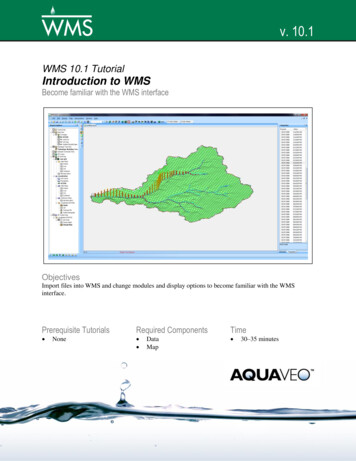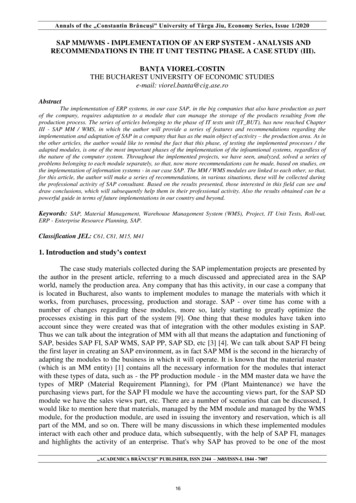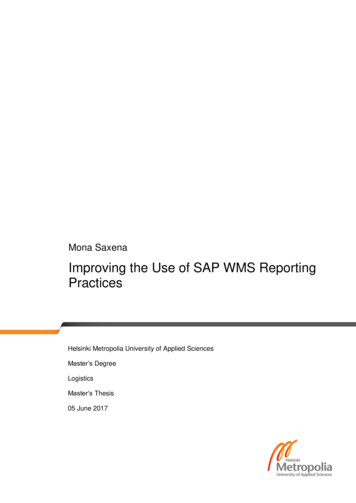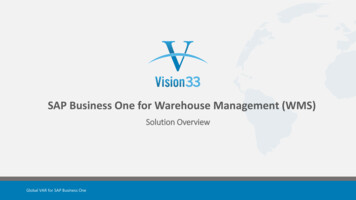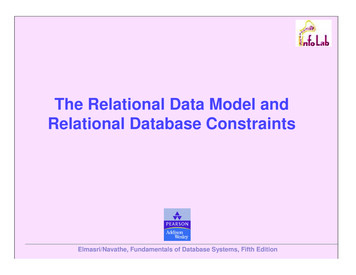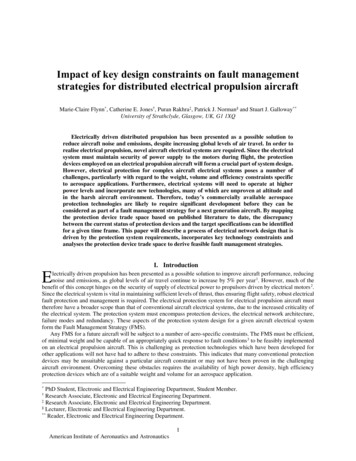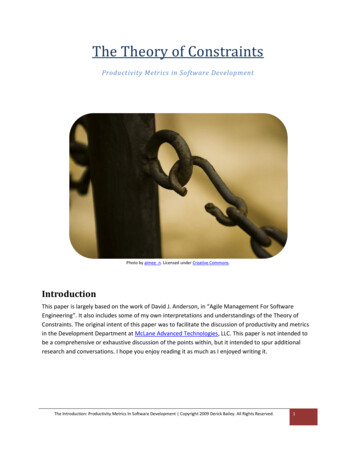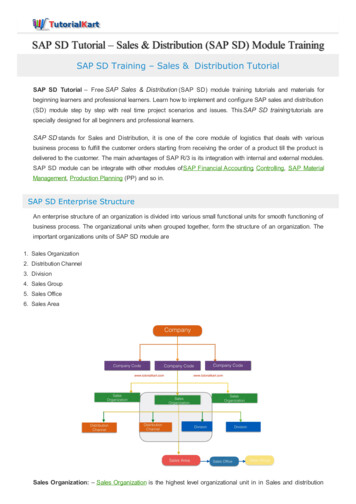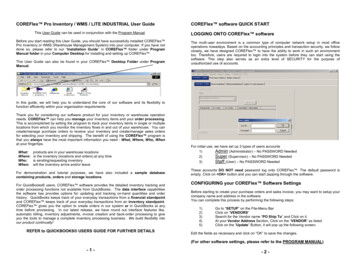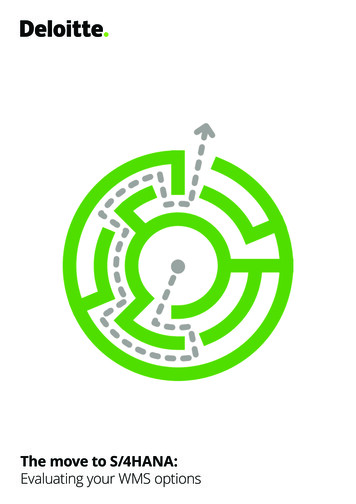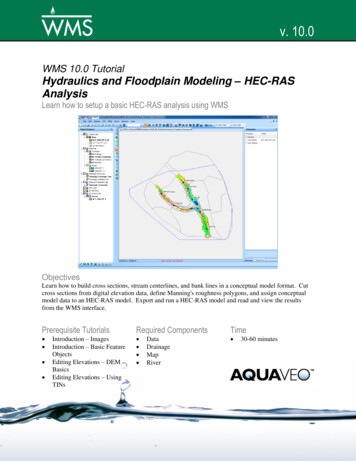
Transcription
SAP WMS IMPLEMENTATION MODULE – CONSTRAINTS, RISKS ANDISSUES. A CASE STUDY FROM AUTOMOTIVE AREA.Viorel - Costin BantaThe Bucharest University of Economic StudiesFaculty of Accounting and ManagementInformation Systems,Management Information Systems Department,Bucharest, RomaniaAbstract: SAP Warehouse Management System module is one of the SAPmodules, which is highly connected to the Material Management module and is usedin companies that use warehouses as a source of material transit. Good warehousemanagement can be done with this module. In this case study, we will analyze howsuch a module was implemented in a company operating in the automotive area. Itis located in Pitesti and, besides the SAP FI / CO modules, SAP SD, SAP MM hasthis module installed. The implementation of the SAP system in this company took 2years and was a successful one, involving a number of 18 Functional consultants(12 seniors and 6 juniors). The technical part was made by the center ofcompetence belonging to the mother company, located in France, in Paris. A seriesof legislative constraints were reported, a series of discussions stemming from this.A lot of reports were developed by ABAP programmers - allocated for thisimplementation by the company that made the implementation, the company locatedin Bucharest. Most issues were encountered in the area of finance - accounting, butalso in the WMS area, where restrictions came from the storage area (a smalldeposit that did not correspond to a detailed organization - as SAP WMS proposes).Due to the fact that what was to be delivered had to be delivered as quickly aspossible, even with very many interventions, due to the fact that the businessenvironment was a dynamic one, the solution was changed four times - thisassuming a delay of 2 months - for go-live. This delay meant an increase of thebudget allocated by 7% - generating many discussions - this was assumed andunderstood by the management of the company.JEL classification: C61, M15, M41, P41Key words: SAP Implementation, ERP - Enterprise Resource Planning, WMS – WerhaouseManagement System, SD – Sales and Distribution, Production, ABAP, Go-Live1. INTRODUCTIONThe implementation of ERP systems in most companies that have resisted thetransition from the socialist economy to the real market economy, after the 1990s, was oneof the conditions for surviving an advanced competitive environment from one day to thenext. The appearance of the big companies, in the Romanian market, facilitated theinsertion within the companies in Romania, of the integrated systems, from OracleApplication, SIVECO, EMSYS, METSYS to SAP. About SAP the author of this articlewill discuss in the following, analyzing the implementation, in a company that activates inthe area of production and sale of products related to spare parts, for cars. This business
area is a new one in Romania, in terms of implementing an application that manages aseries of products, which come from a factory, belonging to the same company. Thus, fromthe implementation of the SAP ERP integrated system (Weidmann C., Teuber L., 2009),with the Financial and accounting modules, until Production, the SAP WMS module is lesscommonly encountered. This would have particularities to keep in mind, so that not allcompanies correspond. Here the author wants to mention, for the future researchers or forthose who are interested in such an implementation, that the SAP WMS module needs agood organization from the company, a very well automated warehouse, very well trainedpeople, knowing a foreign language. mandatory. most of the training manuals being inEnglish. An architect and a good strategist is also mandatory, for thinking about futureproduct organizations, which will be part of the storage process and the subsequent move /sale (Amini M., Savafi, N, 2013).2. LITERATURE REVIEWA number of authors, from abroad, as well as from our country, have writtenvarious articles on ERP system implementations. They all revealed things that happened incompanies, based on the research done (Nemati et. All, 2010). Regarding the modelingpart of SAP, of the processes encountered in the business environment, we can mentionhere a few articles (Leu J.D. and Huang L.T., 2009, Zhou Y., 2009). Globalimplementations have had a major impact on the business environments in the countrieswhere they took place, so many researches highlight the risks and problems that wereencountered in the implementation projects (Elragal and Haddara, 2013). From his point ofview (Rashid and all, 2002) ERP systems were the ones that brought about the mostsignificant change in the perception of the activity carried out in a company, from the pointof view of use, efficiency and meeting the needs. company. According to what (StefanouJC, 2002) he mentions in his research, these ERP systems (P.C.G, 2013) offer aperspective on the combination of several procedures used in the business environment, theexisting applications - subsequently modeled, the departments in which the activity iscarried out, all these things being done in a single database. Thus, redundancy in terms ofdata entered and stored disappears. Throughout my research on ERP systems, the authorhave come to the conclusion that these systems are designed for the computer, to facilitatethe introduction in a single place (database) of all the information and data needed formanagement as well. more efficient business, for which the respective system is new /created (Ha Y. M., Ahn H. J., 2014). Here, the author, would like to remind (O'Leary, DE,2000) that in his studies, he calls this type of system, type ERP, as follows: “ERP systemshave computer-based systems designed to process an organization's transactions andfacility integrated and real-time planning, production, and customer response ”.3. LITERATURE REVIEW – SAP WMSSAP WMS was one of the SAP applications (computer support) that came to meetthose who had and have warehouses, facilitating their organization and management, thespace and the way of organizing the products, the materials existing there, thus facilitatingthe timely and efficient processing of everything. which meant the logistical requirements,coming from a company. With what has come, new, Warehouse Management (WM), wasthat it offers flexible and automated assistance - regarding the management and processingof movements within a warehouse, in terms of goods (related stocks). Within such anapplication (the module within SAP ERP) economic processes are modeled and it can be
accepted that a complex warehouse structure can be defined and managed, used in allmajor warehouses.4. THE BENEFITS, RISKS AND DIFFICULTIES – THE IMPACT FOR THE BUSSINESENVIRONMENT – DISSCUSIONS – INVOLVED PARTIESThere have been a number of discussions regarding the adoption of SAP WMS inthe company. The manager of the Logistics department having a series of branches, hisdissatisfaction, being that he did not find support in understanding the solution that wasconceived by the mother for the Romanian branch. Thus, after thorough investigations itwas found that the final decision is based, as a stage in the SAP implementation project,following the recently more detailed findings in the WMS area, a decision from thebusiness is expected in relation to the implementation of WMS in W1 (Pitesti). Based ondiscussions the business from Headquarter prepared a presentation in which was describedthe current situation in parallel with a draft of the “WMS” situation. They mention that,they would like to put the disclaimer that the “WMS” image is as per their currentunderstanding. They mention that the experienced contribution is highly appreciated. They(the business from Pitesti HQ) mention that, they took into considerations the followingcriteria: storage space availability, flows, warehouse personnel, KPIs, Risks and impact forthe entire business. In the relation to the warehouse operations, the objectives of theRomanian business, located in Pitesti HQ, are: to continue to contribute to the success of the business as a whole. Allfunctions of the company from Romania are members of the same strongteam;to keep\improve the warehouse KPIs;to reduce the risks;to maintain the good customers satisfaction regarding the delivery actionsBelow, the author presents a sketch, as thought by the local business, which willshow the distribution of the future central warehouse, and how WMS will optimize thislocation.Figure no. 1 – Distribution inside of the warehouse
As can be seen from the number one image, when implementing SAP WMS, adiagram should be drawn up to show where and how the materials will be placed, how theywill be part of their movements, from one slot to another. In the following figure (figure 2)we detail the structure of the company, how it is organized:Figure no. 2 – Warehoses flows - designWhat the Romanian center (local business), in fact Pitesti – local employees –managers - asked to the mother company, is to asked SAP CoE, to give recommendationsand expertise from all implementation SAP solutions, especially in the area of SAP WMSsolution. This came from many discussions raised by the management in Pitesti, to theimplementation consultants, and to which no answer was found. The raise the folowingquestions: what we require from COE is a recommendation on what type of WMS dowe have to implement in W1? would it be possible to implement WMS solution in Pitesti? would be a good decision from IT point of view?Based on the answers to the above questions, we can conclude that, themanagement from Pitesti division, have formulated, the folowing requirements: we need more details about flows, number of transactions, number ofdocuments. with the recommendation received, the management will go further to thedecision makers for the business in Romania.In everything described above, we can show below a series of risks that theRomanian business was subjected to, this WMS solution implementation. The big problemof this implementation was the approach in our country versus what the mother companywanted, for this branch. All the discussions, which took some time, led to animplementation from scratch, regardless of the rules in the group. Each party tried toimpose its point of view, but for Romania, this (the law and the business environment) wasone of the key points, under discussion, for that period. In the following table, the authordetails a series of risks, found, throughout the project:
Tablе 1. Validity of thе rеsеarch activitiesSAPModuleWMSDescriptionUser manual missing23Responsetime (MD)3WMSWMS flow to be presented226WMSLabel print to be checked114WMSGood receipt in storage type 901not automaticallyWMS translation in ENG/ROZVLSAM issues1121112123R03 put away strategy modificationfor storage type 305, wasrequested on w34GR in WM R02 R03 remains in 900storage type, for R04 (Sandor) willbe automatically, w35Split Warehouse R03 betweendnormal and DGG sections, this wasrequested on w36323323Some customizing will beaddedYes324YesMM W - R02, R03 and R04 split ofTO profile based on differentpicking areas (301, 305), wasrequested on w47138Material masterdate update,split profile for transfer orderTO, update, proceses will beagain testedMasterdata files on planCriticalOn-going activities, Denizalready finished some of thematerial training, QA checkby WMS senior consultantNex week the WMS seniorwill provide a training /presentation about WMS flowThis will be checked by thesenior WMS consultantThis is solved and will bepresented next week w30YesInstead of ZVLSAMtransaction, was presentedreplanishement standardSAP transcation, and works.ZVLSAM is in polish, nottranslated in EN or ROCheck and test if strategy Kallowed pre-alocation stockYesYesYesYesYesYesYesFigure no. 3 – Risks / Issues situationBased on the figure 3 we can conclude that we have more tasks with priority 1 (5),with priority 2 (2) and with priority 3 (3). What we want to highlight is the fact that mostof the tasks were very urgent, and the priorities changed from day to day, which required agreat deal of stress from the existing consultants in the project. Even the difficulties werevery great, due to the fact that the solution in Romania was a very complex one.
6. CONCLUSIONSThis case study, with the following examples, highlighted a number of difficultiesthat the Romanian business environment encountered after 1990. Many companies wantedto update their IT environment, only as they did. they did it was quite difficult. There are anumber of things that need to be considered when you want to adopt a world-class ERPsoftware package, such as SAP. More and more companies do not take into account theenvironment in which they are, what they have as infrastructure, what people have,prepared or not. These factors greatly influence such a project. Relationships establishedbetween the business environment and the project consultants, can influence thedevelopment of the project for better or worse. This project had many risks and problems,due precisely to the factors set out by the author above. The degree of resolution was veryhigh, due to the tolerance shown by those who were on the project, SAP consultants. Onething that the author wants to bring to the foreground is that of the way in which theRomanian business environment understood very well what it means to use an ERPsystem, the way of working, the data to be added. , of the interpretation of these, inaccordance with the subsequent development of the business. After the studies, it is clearthat there is more to be learned in terms of managing and using an ERP system.REFERENCES1.2.3.4.Nemati, A. R.,Bhatti, A.M.,Maksal, M.,Mansoor, I.,and Naveed F.,Ha Y. M., AhnH. J.Elragal, A.,Haddara, M.,Amini M.,Savafi, N5.P.C.G6.Leu J.D.,Huang L.T.7.Zhou Y.8.Weidmann C.,Teuber L.9. Rashid, M. A.,Hossain, L.,Patrick, J. D.10. Stefanou, J. C.11. O’Leary, D. E.“Impact of Resource Based View and Reso
SAP WMS was one of the SAP applications (computer support) that came to meet those who had and have warehouses, facilitating their organization and management, the space and the way of organizing the products, the materials existing there, thus facilitating the timely and efficient processing of everything. which meant the logistical requirements, coming from a company. With what has come, new .
